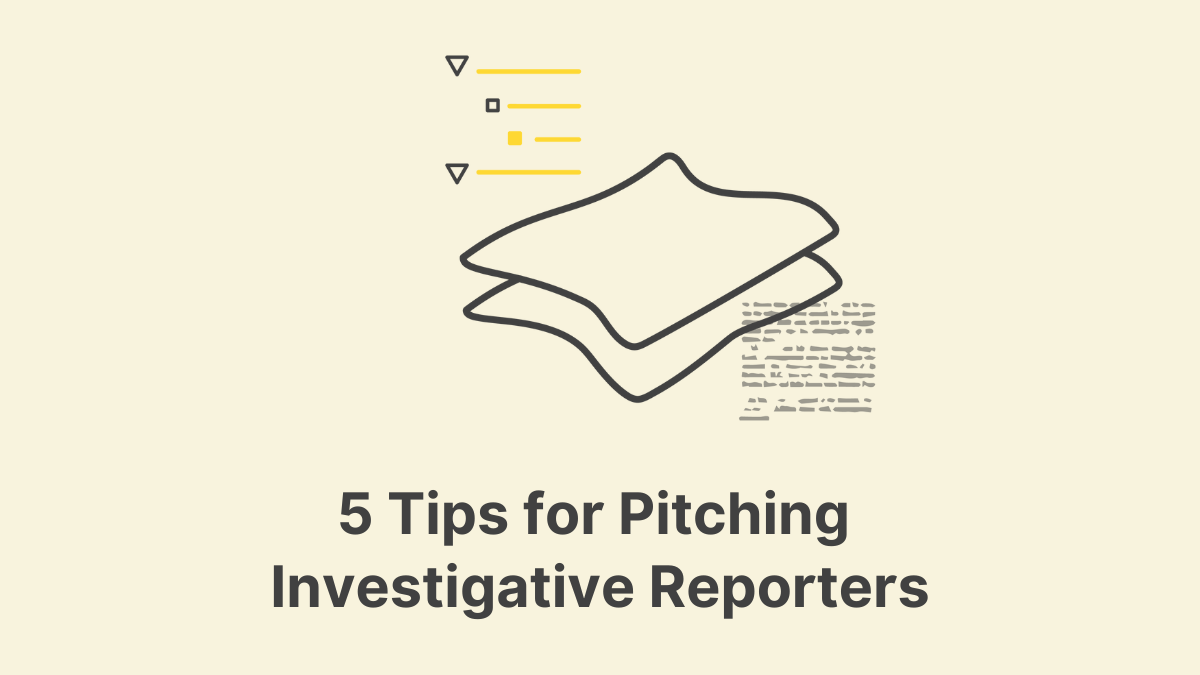5 Tips for Pitching Investigative Reporters

Investigative reporting is all about sussing out a particular topic of interest, which can be anything including crimes, injustice, business malpractice, and more.
However, there isn’t a lot of specific information out there for PRos looking to pitch an idea or story to an investigative reporter.
This is why we sat down with a veteran Colorado-based investigative reporter to give us some of his top tips for getting the eye and ear of an investigative reporter.
The reporter, Tim (using a pseudonym), has asked to remain anonymous given requirements from his news station.
Let’s get into the tips to make your next investigative pitch your best yet, and if you don’t have investigative pitching on your radar now, we hope you can put these tips in your back pocket to use whenever you need them!
#1: Understand What Investigative Reporting Really Is and If It’s Right for Your Pitch
The first tip that Tim shared with us is to simply understand what investigative reporting really is, to ensure that it’s the right avenue for your outreach. Let’s get into the definition.
The Global Investigative Journalism Network defines investigative reporting as “systematic, in-depth, and original research and reporting, often involving the unearthing of secrets.”
In Tim’s words, in investigative reporting, the writing is “different [from] happy story” like a child receiving something from Make a Wish or a donation or charity story.
In other words, you wouldn’t pitch an investigative reporter a story about your client’s new funding round, product release, or acquisition - unless there was some sort of “scoop” element to it.
Jamie Ostroff, chief investigative reporter at NBC affiliate WPTV in West Palm Beach, also feels the pain of ill-timed and ill-researched pitches.
Pro tip for PR reps: Pitching New Year's workout stories to an investigative reporter will win you a one-way trip to my junk folder.
— Jamie Ostroff (@TheJOstroff) December 29, 2022
Investigative reporters are interested in uncovering deeper issues, scandals, or significant impacts from these that may not be immediately apparent.
For this reason, your pitch about a funding round, product release, or acquisition would need unique insights, exclusive “never before shared” information, or a hidden angle that aligns with their investigative work.
Tim also shared that an “investigative story is about relationships and trust” because “you have to be reaching out to investigative reporters” consistently with a tip on “something [that] is wrong” and “you hope they right the wrong.” More on this in a moment!
#2: It’s About Relationships
By now, you’ve heard time and time again that PR is about relationships, but nowhere is this more true than in investigative reporting.
For this tip, Tim shared that it’s “not about texting or emails,” but that you have to “put yourself out there and find, build, and nurture relationships” with investigative reporters you’re hoping to target, much like you would with any other reporter.
The difference is that with investigative folks, the relationship often requires a deeper level of trust and credibility.
Unlike other reporters who might be content with regular updates and press releases, investigative journalists are looking for sources who can provide them with substantive, reliable information that can lead to impactful stories.
#3: Put Yourself Out There
In his experience, Tim’s “biggest tip” for getting out there in your community is researching and knowing exactly who the “investigative reporters in your marketplace” are.
From here, Tim recommends you “ask [them] for coffee to get to know them” and be prepared with pertinent information like “here’s what I do, here are the clients I work with, if you need an expert, here are expert clients I have, we like to get the
Tim also appreciates when PRos “go to public events where ‘movers and shakers’ are attending.
#4: Help Them If You Can
This tip is applicable for any reporter, but with investigative reporting that often requires deeper research and work, making your target reporter’s life easier can go a long way toward getting a response or a pitch open, or even towards the start of a new relationship!
Tim gave us some intel on the kind of questions that investigative reporters are hoping to get answered in their reporting.
These are meant to be thought starters for you when pitching, so that you can gather responses and ensure that they’re reflected in your pitch and exchange with the reporter.
These questions include…
- What happened here, and why?
- How much of this story is black and white?
- How much is a gray area?
- How much can I prove, and how can I prove it?
- How much can I “shake the trees” to get more information?
- What does accountability look like here?
#5: Think in Seeds, Not Stories
While it’s always great to approach any reporter with a built out idea, when working with investigative reporters, you might not always have the full story entirely available or clear to share with the reporter.
This is because in investigative reporting, often the story unfolds over time as more information is uncovered. This is why Tim recommends that just reaching out with a tip can be enough to “be the seed that starts the story.”
Investigative reporters know how to dig deeper and uncover hidden details, so it's okay to approach them with an initial lead or hypothesis rather than a fully fleshed-out narrative.
We’re all about helping you pitch better, whether that’s to an investigative reporter or a tech editor and everyone in between.
For more pitch tips to take the headache out of finding and reaching the right journalists, stay tuned to our blog for weekly insights!
______
Want new pitching and PR intel sent straight to you each week? Sign up below to stay up to date with our newsletter:
